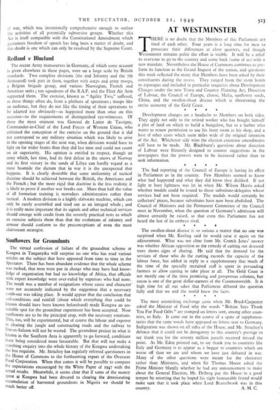Sunflowers for Groundnuts
The virtual confession of failure of the groundnut scheme at Kongwa in Tanganyika will surprise no one who has read various articles on the subject that have appeared from time to time in the
Spectator. There has been abundant evidence that the whole scheme was rushed, that men were put in charge who may have had know-
ledge of organisation but had no knowledge of Africa, that officials with expert knowledge were over-ruled by superiors who had none. The result was a number of resignations whose cause and character•
were not accurately indicated by the suggestion that a necessary comb-out was taking place. It would appear that the conclusion that soil-conditions and rainfall (about which everything that could be known should have been known beforehand) made Kongwa an un- suitable spot for the groundnut experiment has been accepted. Now sunflowers are to be the principal crop, with the necessary rotations. This, too, will be experimental, but of course the labour and expense tn clearing the jungle and constructing roads and the railway to Dar-es-Salaam will not be wasted. The groundnut project in what is known as the Southern Area is apparently to go forward, conditions there being considered more favourable. But that will not make a searching enquiry into the whole history of the Kongwa undertaking the less requisite. Mr. Strachey has regularly referred questioners in the House of Commons to the forthcoming report of the Overseas Food Corporation. When that comes it will be possible to compare the expectations encouraged by the White Paper of 1947 with the actual results. Meanwhile, it seems clear that if some of the money spent at Kongwa had been devoted to clearing the deteriorating 3ccumulation of harvested groundnuts in Nigeria we should be much better off.


































 Previous page
Previous page